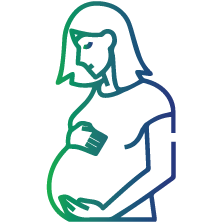
Blood Group ABO and Rh Typing Test
Blood Group ABO and Rh Typing
The ABO system of blood grouping (also called blood typing) is a test used to determine a person’s blood type. Human blood is divided into 4 blood groups, namely type A, type B, type AB, and type O. The presence or absence of certain proteins called antigens on the red blood cells (RBCs) determines an individual’s blood group. Along with blood typing, a blood sample is also tested to find out the Rh factor, which is another type of inherited protein found on the surface of RBCs. Based on its presence or absence, blood may be Rh positive or Rh negative.
This test is also known as Rh typing, ABO blood typing, ABO blood type, cross matching, transfusion-blood typing.
What is Blood Grouping and Rh Typing Test Used For?
ABO blood group and Rh factor test are done under the following circumstances

Blood transfusion

Organ donation

Tissue/bone transplantation

Rh incompatibility between fetus and mother
Test preparation:
No special preparation is required for the test.
To determine the blood group, a blood sample is taken, mixed with antibodies against type A and B blood and checked for agglutination (clumping). If the RBCs stick together, it implies that the blood reacted with either one of the antibodies.
In the second step, called back typing, the serum part of the blood is mixed with type A and type B blood. Individuals with type A blood group have anti-B antibodies, and those with blood group B have anti-A antibodies. Blood group O is when an individual has both types of antibodies.
For determining the Rh factor, the RBCs are tested in a similar way as blood groups; however, this testing is done to find the presence of a certain cell surface protein on the red blood cells. A person is Rh positive if this cell surface protein is present. Its absence makes the person Rh negative
Interpretation of results
Blood groups and their recipients
A. ABO blood groups and their antigens
|
Blood Group |
Antibody present |
Antigen present |
|
Type A |
Anti-B |
Antigen A |
|
Type B |
Anti- A |
Antigen B |
|
Type AB |
No antibodies |
Antigen A and B |
|
Type O |
Both Anti A and B |
No antigens |
B. ABO Blood transfusions
|
Blood Group |
Recipient (Blood receiver) |
|
Type A |
A, O |
|
Type B |
B, O |
|
Type AB (Universal recipient) |
A, B, AB, O |
|
Type O (Universal donor) |
O |
C. Rh factor compatibility
|
Rh factor |
Recipient (Blood receiver) |
|
Rh+ |
Both Rh+ and Rh- |
|
Rh- |
Only Rh- |
FAQs
Which blood group is called the universal donor and universal recipient?
Blood group “O” is called the universal donor, as this blood group can be given to all other blood groups (type A, B, AB, and O). On the other hand, blood group “AB” is called the universal recipient as it can receive blood from all the other blood group types. However, while transfusing blood, the donor’s Rh factor should be checked for compatibility with the recipient’s blood.
Why is it important for pregnant women to undergo Rh factor test?
If a pregnant woman has Rh- blood but the fetus has Rh+ blood from the father, it is important that the woman receives only Rh- blood. If the woman receives Rh+ blood, it could lead to a serious complication called erythroblastosis fetalis, in which the neonatal RBCs undergo destruction due to the maternal immunoglobulin (IgG) antibodies
I have “B-” blood group. Can I receive blood from my sister who is blood group “O+?”
No, this transfusion cannot take place because even though the type B blood group can receive blood from either B or O, there is an incompatibility in Rhesus (Rh) factor. B- is only compatible to receive blood from other negative donors with either type B or O blood groups
What happens when a person with O blood group receives blood from A blood group?
If a person with blood group O receives blood from someone with an A type blood group, the recipient’s immune system identifies the new blood cells as foreign and seeks to destroy them. An incompatible or mismatched blood group would make the RBCs clump or agglutinate, which can influence the circulation of blood in the body in an undesirable way
How is the presence of other minor antigens besides A, B, and Rh antigens detected?
Following cross-matching, a test known as the Coombs test is performed to detect minor antigens that are present in the blood along with the major ones i.e. A, B, and Rh antigens.

